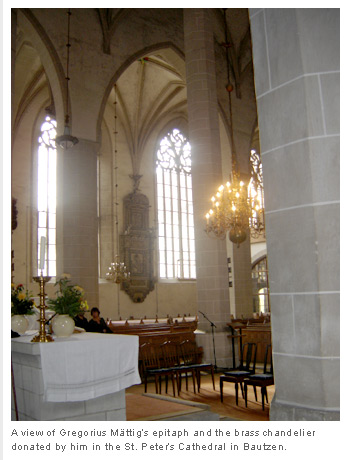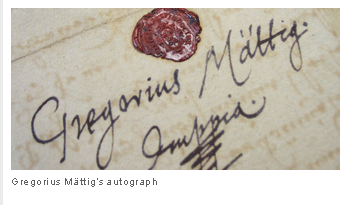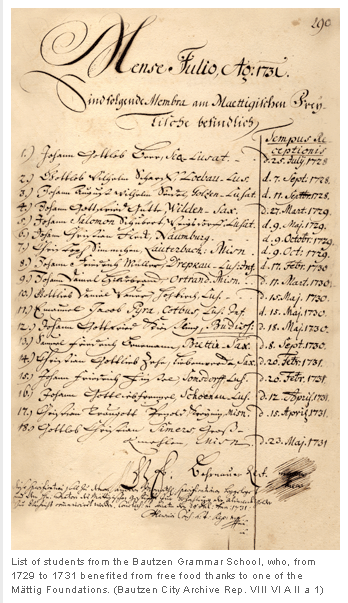 |
 |
 |
About Gregorius Mättig
Gregorius Mättig was born on 25th September 1585 in Bautzen. His father was Franciscus
Mättig, his mother's name was Margarethe Peucer.
His mother was the youngest sister of the great Humanist and scholar, Dr. Caspar Peucer (1525 - 1602),
a son-in-law of Philipp Melanchton (1490 - 1560), the important humanistic scholar and reformer.
Mättig's parents died early during an epidemic.
 Gregorius, his brother
Johann and his sister Anna were looked after by close relatives who encouraged their development. Gregorius, his brother
Johann and his sister Anna were looked after by close relatives who encouraged their development.
The Bautzen senator, city architect, and Gregorius's uncle, Johann Peucker, particularly cared for his comprehensive
education. After having finished his secondary school studies in Bautzen, Gregorius Mättig furthered his
scientific
education at the universities of Leipzig, Strasburg and Basel.
In 1610 he obtained a doctorate in medicine from the University of Basel. In spite of having been offered many
interesting positions to remain in Basel, Mättig decided to return to Bautzen. In 1612 he became supervisor
of the pharmacies of the city; in 1617 he became councilman as well as assessor at the manorial court of the
capital city of the Margravate of Upper Lusatia, which at that time belonged to the Bohemian Crown.
Furthermore, Gregorius Mättig acted as one of the „Defenders of the Faith“ who in the Upper Lusatian region watched
over the protection of the confessional rights of the protestant population in Bautzen vis-à-vis the territorial lords.
In 1621 he resigned all his official duties as a sign of political protest. Mättig rendered great services
through his actions as a doctor in controlling epidemic diseases in Bautzen.
In 1613, he was married to Martha Rosenhain († 1637), the daughter of a wealthy merchant in Bautzen.
This marriage, as well as the second one with Barbara Krantz, remained without issue.
After Bautzen's destruction by fire on 2nd May 1634, caused by imperial troops in the wider context
of the 30-year war, Mättig immediately set out to alleviate the destitution and poverty of his fellow citizens.
Already in 1636, Mättig and his wife (one of Bautzen's wealthiest citizens) had enacted several
charitable trusts. Until the end of his life, Mättig was godfather of over 100 children at
whose birth he had acted as a doctor.
Although Gregorius Mättig's house was situated in Bautzen at the Hauptmarkt, he often stayed at his estate
in Meschwitz, near Bautzen, from 1640 onwards. After his death on 30th March 1650 in Bautzen, his foundations
became operative. These foundations were supported by his assets, his private collections, the revenues from
the Meschwitz estate and from the mill at Blösa, as well as interests and repayments of loans originally
granted to various towns and private persons in the Upper Lusatia region.
 In 1916, the Bautzen city historian,
Richard Wilhelm, In 1916, the Bautzen city historian,
Richard Wilhelm,
wrote the following in evaluating Dr. Mättig:
„Mättig…a blessed life, a life full of work, full of love, full of Christian commitment.
To this splendid man, who stood far above his own time, who was an outspoken fighter for truth
and justice, who was a counsel and a help to his suffering fellow human beings, gentle in his
actions, noble of character and the enrichment of his city the following
words which cover
his epitaph in St Peter's church, fully apply until this very day:
’Immortal remains the glory of the man who, even without a monument, is known to Budissin through his kind donations.’“
Other testimonials of Gregorius Mättig
Johann Christian Bulitius from Kotitz, 1750
„Love, generosity and kindness have made it possible that during 3 years I could benefit from free
room and board which was provided through Mättig's benevolence. This great benefit, rendered for my education,
reduced the financial burden of my parents. May God bless this good deed and reward the benefactors and the
entire city manifoldly“
Budißinische Nachrichten und Unterhaltungen, 1775
(local newspaper)
„… whom after more than 120 years after his passing is still to be
considered as a benefactor to the human race. He therefore deserves that we keep his memory alive
and renew it, far more so than others who gain fame through nothing else but by a noble descent,
or by accidentally holding a high office, or even through destructions which they cause in the
world and by their vice and folly. We conclude…with the most devout wishes that God may often
grant our city and our schools men who resemble Mättig."“
Budißinische Unterhaltungen und Nachrichten, 1777
„To whom would the name of Mättig not be known, even if one had only lived for a brief time
in the city of Bautzen ? He is a benefactor, the upholder, the father of many thousands, whose
glorious memory is glorified by grandchildren and their children throughout the ages. Never
forget the sacrifice of gratitude! Many noble fiery geniuses would have perished to the greatest
sadness of their contemporaries had not Mättig's benefaction saved them from the shackles of sorrow.“
Kantor Löschke, 1821
(choirmaster and organist)
„… particularly, there are significant means present in the stated will of Dr. Mättig.
These cannot remain any longer unappreciated in Saxony and under the government of King Friedrich August,
even if they have been unacknowledged for many hundreds of years.“
Richard Wilhelm, 1916
„Hundreds of thankful scholars from the local school have, over the course of the last centuries,
benefited from Mättigs rich donations. One of those scholars, the lawyer Otto Leonhardt, born in Bautzen
and living in Marienberg, installed a memorial plaque at the house on the Market, on 30th April 1870,
as a sign of true and heartfelt reverence for Mättig…“
Dr. Martin Reuther in „Geschichte des Bibliothekswesens in der
Stadt Bautzen“, 1955
(History of librarianship in the city of Bautzen)
„The greatness of this man lies in the fact that he spent his life wholeheartedly
in the service of science and charity. Mättig, successful as a doctor in the control of
epidemics, is one of the few patricians who donated his entire sizeable fortune to the
poor of his town, through his foundations and donations.“
Hermann Graf Pückler, 2006
„Our common welfare is based on such personalities as Dr. Gregorius Mättig. I am
impressed by this foundation and its aims. The revival of such a foundation is
not only socially very worthy, but also sets an example.“
The Foundations of Dr. Gregorius Mättig
 In Dr. Mättig's
will of 9th May 1650, foundations with the following aims were enacted: In Dr. Mättig's
will of 9th May 1650, foundations with the following aims were enacted:
- To provide free meals for schoolchildren of the town school who were also members of the protestant
live-in choir at the St Peter's Cathedral. From 6 to 20 schoolchildren annually benefited from these free meals.
In 1762, the free meals were stopped and converted into a weekly monetary allowance of one Reichstaler
per schoolchild.
- To provide free cloth to clothe poor schoolchildren.
- To annually provide three University scholarships for descendants
of Dr. Mättig's family and for talented yet impecunious children in Bautzen.
- To provide financial support for the protestant clergy of the St Peter's Cathedral.
- To provide financial means for the acquisition of candles to adorn
the large chandelier in the St Peter's Cathedral.
- To provide financial means for the upkeep of Dr. Mättig's funerary
monument as well as the pulpit in the St Peter's Cathedral, also donated by Dr. Mättig.
- To provide financial means for the upkeep and aggrandisement of
Dr. Mättig's library, which he donated to the city of Bautzen.
- To provide financial support to poor female descendants who wish to marry.
- To provide apprenticeship premiums to poor male descendants.
- To provide financial assistance to poor old people.
- To provide bread and beer to the occupants of the Bautzen hospital.
The curator of the foundation would also receive a fee. All in all, a total amount of 24,250 Reichstaler was set aside for all these purposes.
Most benefits of these foundations went to the children of the local school in Bautzen. Hundreds of talented
young people thus obtained the necessary material requirements in order to benefit from a decent basic and further education.
The annual grants were donated following a school feast. This tradition was carried on even late into the 19th Century and
constituted a highlight in the local calendar.
If one analyses these individual foundations, it becomes clear that the main purposes of Dr. Mättig were the
development and education of the young, as well as the promotion of spiritual and cultural life. In a time
of suffering and need, the city doctor and erstwhile councillor, Dr. Gregorius Mättig (1585 - 1650)
stipulated in his will that several foundations should see the light of day, which would not only
benefit the burghers of Bautzen, but also people who had previously lived in the city and even
further afield. Dr. Mättig's charitable foundations spread their benefits for nearly 300 years,
before they were left devoid of any financial means due to inflation and wars. In the years
following the Second World War, they ceased functioning - ideologically speaking, private
initiatives were not high on the agenda in those days… In 1949, the Mättig foundations were
incorporated into a general city foundation. The former power and dynamics of the Mättig
foundations was lost.
 The few
proceeds left over from the Mättig foundations were allocated for different cultural purposes. Members of the Lissack family,
themselves descendants of Gregorius Mättig, asked themselves if the aims and the goals of these foundations had not, in fact,
remained timeless and The few
proceeds left over from the Mättig foundations were allocated for different cultural purposes. Members of the Lissack family,
themselves descendants of Gregorius Mättig, asked themselves if the aims and the goals of these foundations had not, in fact,
remained timeless and
if therefore a revival would be desirable.
Through talks with several city officers, the the district Sparkasse Bank of Bautzen, several private individuals and institutions, it became
clear that this was indeed an issue to be followed up and the goal for such a revival was supported.
The documents relating to the Foundations' administration, which are still preserved in the city archives,
prove in a rather impressive way the foundations' effects on the development of spiritual life in Bautzen,
especially during the 18th and 19th Centuries. Further effects of Gregorius Mättig's actions can be witnessed
until this very day.
The city library is the proud recipient and curator of a rich inventory of historical books from
Mättig. Through Mättig's legacy for the creation of non-resident chorister places,
he fostered the city's musical life.
The St Peter's Cathedral is still adorned by two brass chandeliers, donated by Mättig, as well as his epitaph. |
 |
 |
|
 |

